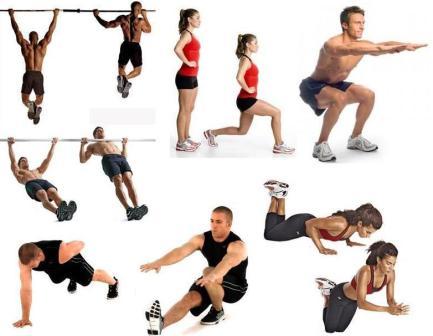It is finally the point in the semester where the warm days aren’t just once in a blue moon, but are now frequently every week. While this is far better than having to bundle up in jackets over sweatshirts every day, it has its downsides. There is almost no consistency with this kind of weather; one day it could be 70 degrees outside, yet two days later it could be back in the 30’s. But during the few days that it is warm outside, there is no reason to not go out and enjoy the weather by working out outside. Some people may argue and say that it is not possible to do their kinds of exercises outside, like weight lifters, but with a slight change in that person’s workout method, it is possible. The easiest way to adapt a prior workout to one that can be done outdoors is by bodyweight training. Bodyweight exercises involve strengthening many of the same muscle groups, but without the help of a machine to add resistance. One article about bodyweight exercises is Greatest which discusses some of the key benefits to bodyweight training. One major benefit of training without machines is that it is an extremely efficient workout. Instead of having to move from one machine to another while constantly changing the amount of desired weight, bodyweight workouts make it easy to transition from one move to the next with little rest in between. Another benefit is that it not only involves strength training, but it also acts as a cardio workout at the same time. Without the countless rests that there would in between machines at gym, bodyweight exercises will keep the heart pumping to improve cardio, while still encouraging muscle and strength development. The last benefit that is most alluring to the general population is that bodyweight training is 100% free. There is no cost of having to drive to the gym, pay for a gym membership, or even buy your own weights; nearly every bodyweight workout can be done in one’s own backyard.

http://watchfit.com/wp-content/uploads/2015/10/body-weight-exercise-benefits_1-1024×683.jpg
There is no limit to the variety of bodyweight exercises a person can perform. This is because there is always some kind of variation that made or a different way to work a different part of the exact same muscle. Jason Ferruggia lists 20 of the best bodyweight exercises for building strength and muscle. They range all the way from simple pull-ups to complicated handstand push-ups and L-sits. These exercises don’t simply train the muscle, they improve flexibility and are far easier on the joints than using resistance machines. Nearly every exercise listed is some variation of calisthenics, but they can be used to cause immense improvements on an individual’s overall muscle mass. These exercises build muscle while getting rid of unwanted fat at the same time. While machines almost exclusively require the user to sit down, bodyweight exercises require the opposite. Virtually every exercise is performed while standing up, improving the individual’s balance, and burning calories by causing the exerciser to be much more active during his/her workout. None of the workouts will lock the exerciser into a certain range of motion like any machine would, and each side of the body is equally trained unlike the machines at the gym that can cause a person to unintentionally work out one side of his/her body more than the other. This unequal distribution of muscle is one of the easiest ways to cause an injury while working out.

http://1bodyweighttraining.com/wp-content/uploads/2015/05/best-body-weight-exercises.jpg
One resourceful but not so beneficial property that machines utilize is a mechanical advantage. A mechanical advantage allows the user to choose a heavy weight on a machine while actually lifting or pulling less than that actual weight. This means that while a person may think that he can bench press 200 pounds on a machine bench press, he may very well be lifting much less than that. This is not possible when doing body weight exercises. As long as the individual performs the exercises correctly, he/she will not have the ability to lift any less than his/her true body weight. This might be somewhat disappointing at first as the exerciser used to believe he/she could lift more than he/she actually could, but bodyweight exercises give the exerciser a true representation of how much he/she can lift with each muscle group. Start Bodyweight discusses the benefits and shortcomings of both bodyweight exercises and weight training exercises. While machines allow the user to focus on one specific muscle to work out, bodyweight exercises can work that exact same muscle while also training various muscles around it, albeit that first muscle may not be trained to the same extent as it would have been on a machine. This increases the overall increase in muscle mass of the body, and allows for a person to become fit more quickly. After reading this post, I hope every person can see both how beneficial bodyweight training can be and how this almost exclusively indoor sport can easily be continued outdoors allowing the exerciser to reap the benefits of this short-lived amazing weather.

This sounds like an interesting blog series topic. I don’t get to exercise as much as I like, so it was interesting to read about the different types of work outs that can be done without machines and the benefits for doing so. I look forward to reading other tips for work outs.
This post was interesting to read. I think you did a great job of presenting all the information in a way that doesn’t throw everything in the readers face all at once. The organization of the post was well put together as well, and I found it to be very informative. Great job!